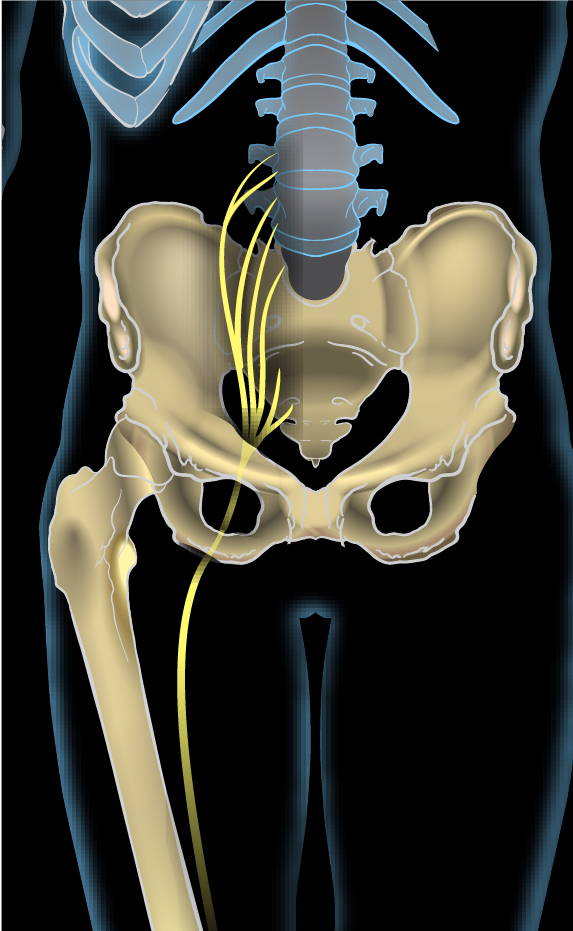By Tim Bochnowski
“A tapped sciatic nerve
What good does this serve me?
I need an ambulance quick
I’m ruined rheumatically”
-The Toy Dolls
Sciatica is a common painful disorder affecting the leg. The sciatic nerve runs from the lower back through the buttock and into the lower leg. Sciatica causes pain, tingling or numbness along the nerve. Pain can stem from many different causes, including herniated disc, spine trauma or piriformis syndrome. The pain could also be triggered by the pedaling motion and/or aggravated by being hunched over and seated for long periods of time while cycling.

• Sciatic nerve2.jpg from Wikimedia Commons
• License: Creative Commons Attribution-ShareAlike 4.0, https://en.wikipedia.org/wiki/Sciatica#/media/File:Sciatic_nerve2.jpg
There is a whole host of stretching, recovery, maintenance and pain relief options available to cyclists who are encountering sciatic issues. Medical professionals can show you how to correctly stretch and treat the symptoms. As always, when issues arise, seek medical advice from your personal physician or medical professional first. They can identify what sort of injury you have, making sure you get appropriate treatment for your condition.
Riding a bike can put pressure on your spine, gluteal muscles, tailbone and sciatic nerve. The saddle can cause compression of the muscles and pinch the sciatic nerve. An ill-fitting saddle that does not support the sits bones can irritate the piriformis and sciatic nerve. I’ve had good success with a channeled or cut-out flat top saddle for a variety of injury problems. Replace all worn saddles. Several saddle manufacturers offer great selection in shape and padding. A few of my favorite saddles come from Cobb, WTB, Terry, SMP and ISM. Find a fitter with a large demo saddle fleet and spend some time trying the various shapes and saddle angles.
Next, the forward lean associated with cycling may lead to tightness in the hip flexors, muscle imbalance and weak gluteal muscles. Your pelvic tilt may contribute to sciatic pain. Raising your handlebars and stem might help in unloading saddle pressure. Try sitting up more on the bike, stretching your back when convenient. The tilt of your bar and saddle can easily be adjusted by a bicycle fitter.
Could saddle height adjustment help sciatica? Maybe…A saddle set too high may rock a cyclist side to side while trying to reach the bottom of the pedal stroke. This rocking can aggravate the muscles and nerve. Similarly a low seat, high torque, heel down pedaling technique, as associated with seated hill climbing, may also cause pressure and excessive hip and knee movement.
Most cases of sciatica resolve with time and respond to conservative methods of treatment. Rest, cross training, hot and cold compress, physical therapy and anti-inflammatory/pain medicines may all be ordered by your physician. Alternative therapies including acupuncture, massage and yoga may also offer relief. Exercises that strengthen the core muscles are often prescribed. These exercises can stabilize the spine and undue pressure on the sciatic nerve. Finally hip flexor and psoas stretches could be beneficial.
In the end, the importance of having a good bicycle position is recognized by cyclists. While considering these aforementioned ideas utilized in bicycle fitting, keep in mind, nothing beats a good bike fit from a well-trained and experienced fitter. Comfort and efficiency breeds’ performance. Keep working at improving your position and ride more bike.
Tim Bochnowski is a bicycle fitter at Mountain Velo in Park City, UT. Fitting bicycles since 1985, Tim had clients win both 2014 USA U23 Road and Mountain Bike National Championships. He has been trained by BIKEFIT, Slowtwitch, Retul and several other fitting techniques. To schedule a fit, Tim can be reached at 435-575-8356, [email protected] or www.mountainvelo.com.


I don’t use a push bike to commute but use a training one in the gym, i use the bike to keep fit. But also have tingling in my upper right thigh.
Any tips and advises will be really helpful.
Excellent article, I benefited slot.
Thank you.
Regards
Shihab/ UK.